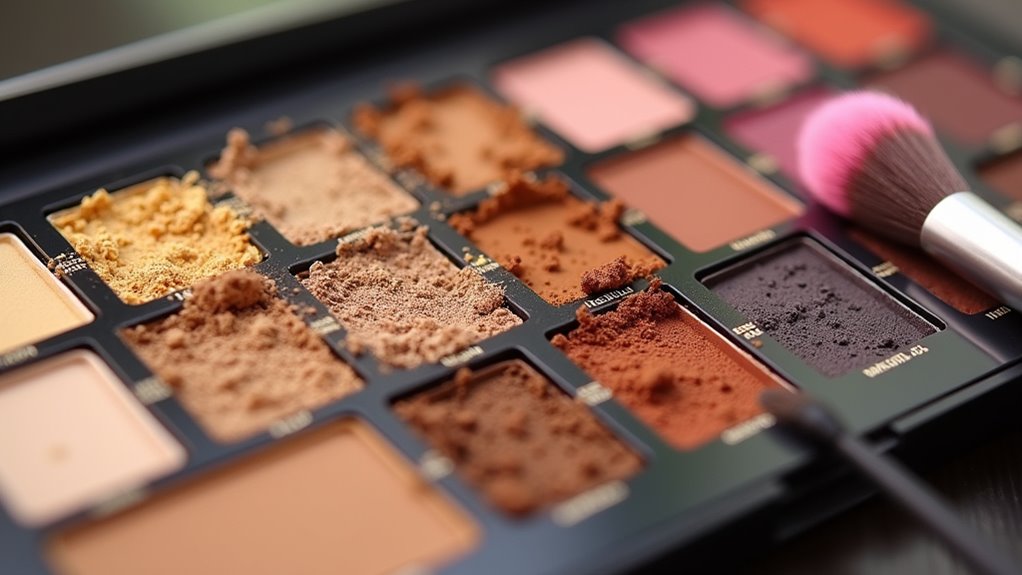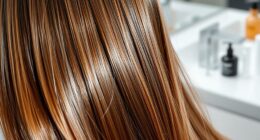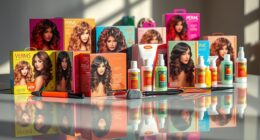Understanding makeup ingredients helps you choose products that suit your skin and avoid potential irritants. You’ll find different pigments, emollients, preservatives, and stabilizers listed on labels, with natural or synthetic options that impact safety and environmental factors. Recognizing common allergens like fragrances or dyes can prevent reactions. Knowing how ingredients are listed and what they do empowers you to make informed, confident choices. Keep exploring to discover how to select the safest, most effective makeup for you.
Key Takeaways
- Reading ingredient labels helps identify pigment types, emollients, preservatives, and potential allergens.
- Natural ingredients are sourced sustainably but may cause allergies; synthetics ensure stability and safety.
- Understanding ingredient order reveals product concentration and potency of active components.
- Recognizing common allergens like fragrances, dyes, and preservatives can prevent skin reactions.
- Selecting products with certifications and testing ensures safer, skin-compatible makeup choices.
Common Makeup Ingredients and Their Functions
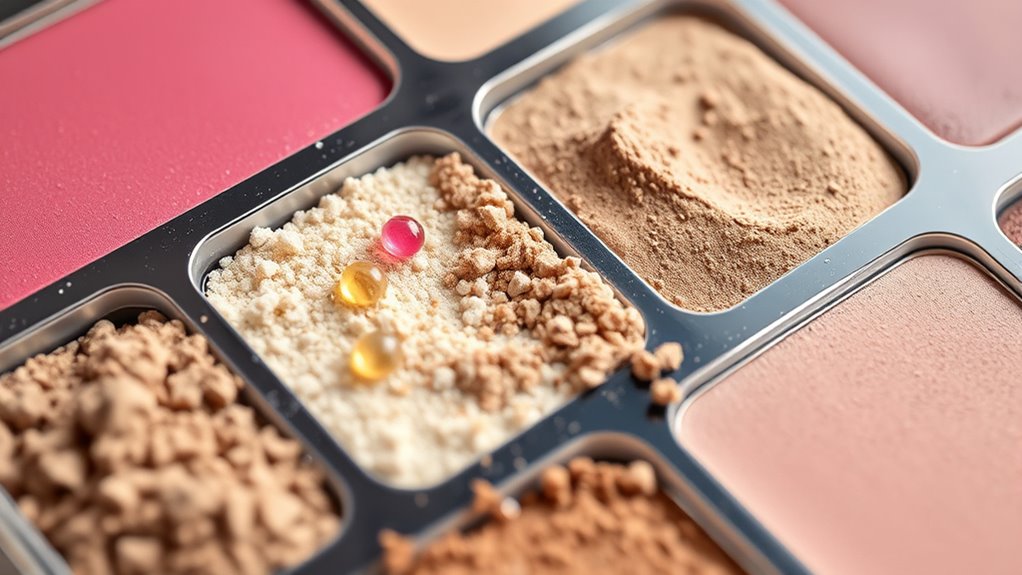
Understanding the ingredients in your makeup can help you make informed choices about what you’re applying to your skin. One key aspect is the variety of pigment types, which determine the color payoff and finish. These include mineral-based pigments, synthetic dyes, and organic colorants, each offering different effects and safety profiles. Emollient functions are also essential; ingredients like oils and butters help smooth the product onto your skin, providing hydration and a comfortable feel. They create a barrier that locks in moisture and enhances blendability. Recognizing these ingredients allows you to select products suited to your skin type and preferences. Additionally, understanding aesthetic enhancements like color schemes and natural elements can help you choose makeup styles that complement your overall look. Being aware of skincare-friendly formulations can also help prevent potential irritations or breakouts when selecting makeup. By understanding pigment types and emollient functions, you gain a clearer picture of how makeup works and how it interacts with your skin.
Understanding Ingredient Labels and How to Read Them
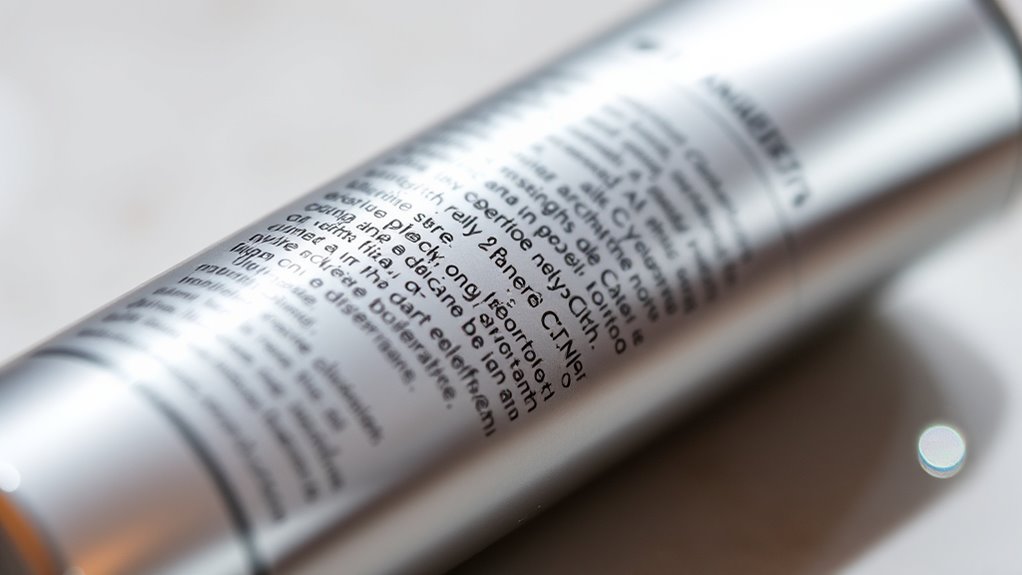
Reading ingredient labels can seem intimidating at first, but knowing how to decipher them empowers you to make safer and more informed choices. Labels list ingredients in order of concentration, so the first few are the most prevalent. Familiarizing yourself with common ingredient names helps you identify potential irritants or allergens. Keep in mind that labeling regulations vary by country, but they generally require manufacturers to list ingredients clearly and accurately. Understanding ingredient sourcing can give you insight into how products are made and whether they contain ethically sourced or potentially harmful components. Learning to read labels helps you avoid unwanted substances and select products aligned with your values. Additionally, understanding ingredient technology can help you better comprehend how specific components function within cosmetic formulas. Recognizing exfoliating agents like glycolic acid can assist you in selecting products suited to your skin needs. Developing a comprehensive understanding of ingredients enhances your ability to navigate the vast array of cosmetic options confidently. With practice, you’ll become confident in steering through ingredient lists and making smarter cosmetic decisions. Furthermore, being aware of mindfulness techniques can help you stay present and avoid impulsive purchases, leading to more thoughtful choices.
Natural vs. Synthetic Components in Cosmetics

When choosing between natural and synthetic ingredients, you should consider their purity and safety for your skin. Natural components often seem safer, but they can cause allergies, while synthetics are designed for stability and consistency. Additionally, think about how each option impacts the environment, since some ingredients have a larger ecological footprint than others. For example, diverse designs available in planters demonstrate how eco-friendly materials can be incorporated into products, reflecting a growing emphasis on sustainability. Moreover, understanding the AI safety measures in place can help you make more informed decisions about ingredient safety and environmental impact. Being aware of ingredient safety standards can further guide your choices toward healthier cosmetic options, especially as research into sound healing science reveals how certain frequencies and ingredients can influence skin health and overall well-being.
Purity and Safety
Have you ever wondered whether natural ingredients are truly safer than synthetic ones in cosmetics? The answer depends on how ingredients are sourced and regulated. Natural components often come from ingredient sourcing that emphasizes purity and minimal processing, but they can also carry contaminants if not carefully controlled. Proper sourcing standards and testing are crucial to ensure safety. Additionally, the manufacturing processes for both natural and synthetic ingredients play a vital role in determining their safety and quality. Synthetic ingredients, on the other hand, are manufactured under strict regulatory standards, ensuring consistency and safety. However, some synthetic chemicals may cause allergic reactions or sensitivities in certain individuals. It’s essential to check labels and understand that both natural and synthetic ingredients can be safe or risky, depending on their quality, purity, and how they’re handled during manufacturing. Ultimately, knowing the regulatory standards helps you make informed choices about what you apply to your skin.
Environmental Impact
Natural and synthetic ingredients in cosmetics have different environmental footprints, influencing their overall sustainability. Natural ingredients often come from renewable sources and can be biodegradable, reducing pollution. However, harvesting them may lead to habitat disruption if not managed responsibly. Responsible sourcing is crucial to ensure that natural ingredient extraction does not harm ecosystems. Additionally, the use of biodegradable materials in packaging further reduces environmental impact and supports sustainability efforts. Synthetic ingredients, on the other hand, are typically produced in labs, which can lower pressure on ecosystems but may involve energy-intensive processes and chemical waste. To minimize environmental impact, many brands focus on eco-friendly ingredients and sustainable packaging, ensuring products are both effective and environmentally conscious. Choosing cosmetics with natural ingredients and supporting brands committed to sustainability helps reduce your ecological footprint. By being mindful of ingredient sources and packaging, you contribute to a healthier planet while enjoying beauty products. Additionally, the development and use of green chemistry in cosmetic formulation aim to reduce the environmental impact of both natural and synthetic components. A focus on sustainable practices in manufacturing further enhances the eco-friendliness of cosmetic products.
Potential Allergens and Irritants to Watch For
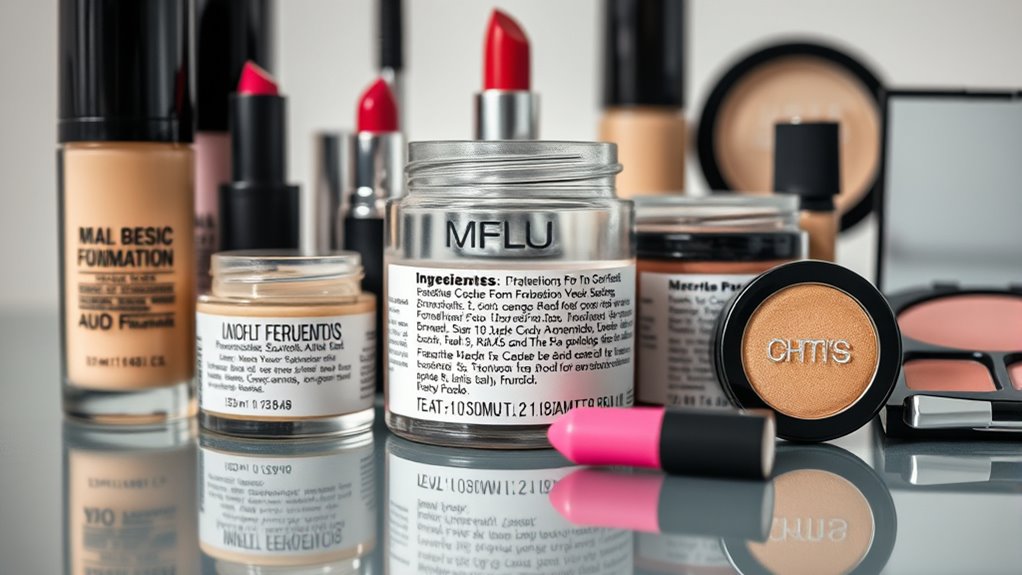
Many common makeup ingredients can trigger allergic reactions or irritate sensitive skin, so it’s essential to know what to watch for. Chemical sensitivities vary from person to person but often involve ingredients like certain dyes, preservatives, and alcohols. Fragrance allergies are also common, especially with added perfumes or scent-masking agents, which can cause redness, itching, or swelling. Look out for labels that specify “fragrance-free” or list natural extracts instead of artificial fragrances. Additionally, ingredients like parabens, formaldehyde-releasing preservatives, and certain dyes can be problematic for sensitive skin. Always patch-test new products before full application, and if you notice any irritation, discontinue use immediately. Being aware of these potential allergens helps you choose safer makeup options and protect your skin’s health. Recognizing the potential for overdiagnosis in health screening highlights the importance of carefully evaluating product ingredients to avoid unnecessary skin reactions. Incorporating hypoallergenic formulations into your routine can also reduce the risk of adverse reactions. Moreover, understanding the safety profiles of ingredients can guide you toward products that are less likely to cause irritation.
The Role of Preservatives and Stabilizers
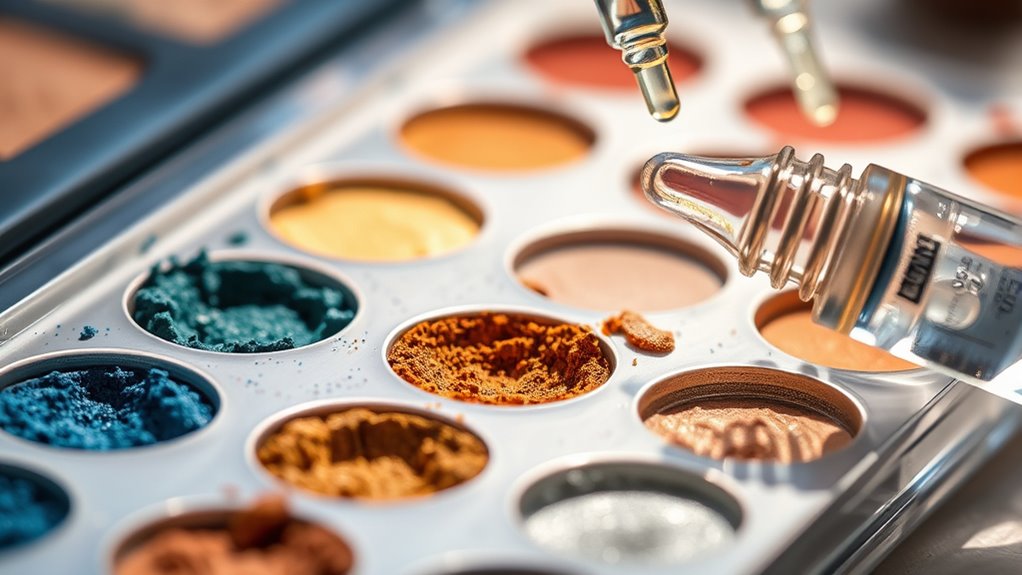
Ever wondered how makeup products stay safe and effective over time? Preservatives prevent bacteria, mold, and yeast growth, extending shelf life. There are various preservative types, including parabens, phenoxyethanol, and natural options like essential oils. Stabilizers help maintain product consistency and prevent separation or degradation. They support preservative functions by keeping formulas stable. Here’s a quick overview:
| Preservative Types | Stabilizer Functions |
|---|---|
| Parabens, Phenoxyethanol | Maintain texture and prevent separation |
| Natural preservatives | Improve shelf stability |
| Formaldehyde releasers | Enhance formula consistency |
| Organic options | Support active ingredient stability |
Together, preservatives and stabilizers ensure your makeup remains safe, effective, and enjoyable to use.
Tips for Choosing Safe and Suitable Makeup Products

When selecting makeup, always read labels carefully to understand what’s in the product. Prioritize products that match your skin type and avoid ingredients that might cause irritation. This approach helps you choose safe and effective options tailored to your needs.
Read Labels Carefully
Reading labels carefully is essential to guarantee the makeup products you choose are safe and suitable for your skin. Pay attention to ingredient sourcing, which can reveal if ingredients are ethically or sustainably obtained. Understanding label terminology helps you identify potentially harmful components or allergens. Look for clear, accurate ingredient lists and avoid products with vague terms like “fragrance” or “parfum.” Check for certifications or labels indicating hypoallergenic or dermatologist-tested products. Use this table to decode common terms:
| Term | Meaning |
|---|---|
| Parfum / Fragrance | Contains added scent, may cause allergies |
| Hypoallergenic | Less likely to trigger reactions |
| Cruelty-Free | Not tested on animals |
Being attentive to labels ensures you select makeup that aligns with your safety and ethical standards.
Prioritize Skin Compatibility
To guarantee your makeup is safe and comfortable for your skin, prioritizing skin compatibility is essential. Look for products with hypoallergenic formulations to minimize the risk of irritation. Check that the makeup helps maintain your skin pH balance, preventing dryness or breakouts.
Consider these tips:
- Choose products labeled as hypoallergenic if you have sensitive skin.
- Opt for formulas that support your skin’s natural pH balance.
- Avoid ingredients known to cause allergies or irritation.
- Test new products on a small skin patch before full application.
Frequently Asked Questions
How Do I Identify Harmful Ingredients in Makeup Products?
To identify harmful ingredients in makeup products, start by reading the chemical labelling carefully. Look for ingredient abbreviations you don’t recognize, and do some quick research on any unfamiliar terms. Avoid products with known irritants or toxins, such as parabens or phthalates. Trust reputable brands that disclose full ingredient lists. By staying informed and attentive, you can make safer choices and protect your skin from potential harm.
Are Organic Ingredients Always Safer Than Synthetic Ones?
Think of organic ingredients as a garden in full bloom—beautiful and full of natural benefits. But just because something’s organic doesn’t mean it’s automatically safer; chemical safety matters too. Sometimes, synthetic ingredients are well-tested and safe for your skin, while some organic ones may cause allergies. So, it’s essential to research each product individually, rather than assuming organic always equals safer. Your skin deserves careful consideration!
Can Makeup Ingredients Cause Long-Term Health Issues?
You might wonder if makeup ingredients can cause long-term health issues. While some ingredients pose risks, ingredient safety largely depends on proper ingredient regulation and individual sensitivities. Many products are rigorously tested to meet safety standards, but certain chemicals may accumulate over time, potentially leading to health concerns. Always check labels, choose reputable brands, and stay informed about ingredient regulation to minimize risks and protect your long-term health.
How Do Preservatives in Makeup Affect Skin Aging?
Preservatives in makeup can impact skin aging if they’re not safe for long-term use. Poor preservative safety may lead to skin irritation and inflammation, which accelerates aging signs like wrinkles and dullness. To prevent aging, choose products with gentle preservatives or those labeled for aging prevention. Always check ingredient lists and opt for makeup that prioritizes skin health, reducing unnecessary exposure to potentially harmful chemicals that could speed up the aging process.
What Are the Best Practices for Patch Testing New Products?
To prevent product allergy, you should always do skin patch testing before trying new makeup. Apply a small amount of the product on your inner wrist or behind your ear and wait 24-48 hours. Watch for any redness, itching, or swelling. This simple skin patch testing helps identify sensitivities early, reducing the risk of irritation and ensuring safe product use. Remember, consistent patch testing is key for allergy prevention.
Conclusion
By understanding makeup ingredients, you can make smarter choices and protect your skin. Did you know that over 60% of cosmetic products contain at least one ingredient linked to allergies or sensitivities? Being aware of labels, natural versus synthetic components, and potential irritants helps you pick products that suit your skin type. Stay informed, read labels carefully, and choose safe, effective makeup that enhances your beauty without compromising your health.
